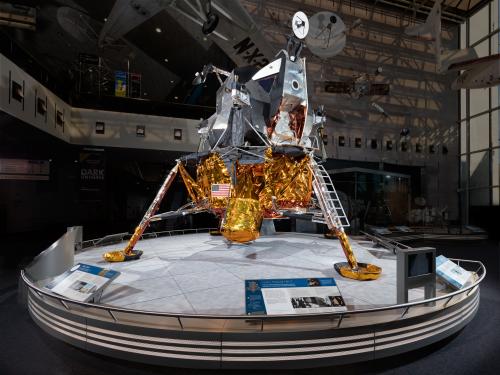
Stories of daring, stories of technological feats, stories of prevailing against the odds ... these are the stories we tell at the National Air and Space Museum. Dive in to the stories below to discover, learn, and be inspired.
Showing 51 - 60 of 91

July 31, 2018
During the conservation of the Museum's Ranger 7 spacecraft, our conservator and space history curator uncovered some unexpected details about the object.

July 20, 2018
On July 20, 1969, a whole nation tuned in to see astronaut Neil Armstrong take one small step on the surface of the Moon, ushering in a new era of space exploration. But how did Armstrong and the Apollo 11 astronauts get to the Moon in the first place?

January 30, 2018
Tomorrow's supermoon is actually being called a “super blue blood moon,” and it’s really rare. Here's what to look for.

January 03, 2018
If you looked up at the sky on January 1, you might have witnessed something spectacular--the Moon kicked off the year with the biggest full moon of 2018, a supermoon. But what about the Sun; did you know that it can be super, too?

August 17, 2017
If you can’t be in the path of totality for a solar eclipse, don’t lose heart! You can still see the eclipse from outside that limited region. The partial phases of the eclipse (when the Moon only partially blocks the Sun) will be visible over a huge area. Here are some reasons why your partial eclipse experience will be awesome.

August 15, 2017
On Monday, August 21, Astronaut Randy “Komrade” Bresnik will have an unbelievable view of the solar eclipse, set to pass across the United States. Bresnik will watch the solar eclipse from the International Space Station (ISS)—he should be in orbit over the U.S. at exactly the right moment.

May 12, 2017
The United States played host to an extraordinary phenomenon known as a total solar eclipse on August 21, 2017. A solar eclipse occurs when the Moon passes between the Sun and the Earth. Eclipses have occurred throughout history, and some have fascinating stories associated with them. Take the following two tales for example.

April 26, 2017
When the Museum’s Apollo Lunar Module (LM-2) moved to a prominent place in our Boeing Milestones of Flight Hall last year, it was an opportunity for us to examine the artifact in fine detail. We spared no effort to preserve, refurbish, and document the iconic object before it went on display in our central gallery in 2016. With careful research and close examination of photography from the Apollo 11 mission, we have been able to refine the accuracy of the external appearance of our LM-2 to more and more closely represent the appearance of LM-5 (Eagle) on the Moon.

January 19, 2017
Captain Eugene Andrew Cernan died Monday, surrounded by his family in Houston, Texas. He was 82 years old. For more than half his life, he was known as the Last Man on the Moon, but he was also a devoted father and husband, a naval aviator and advocate, and a great friend to many. He remains a hero for the ages.